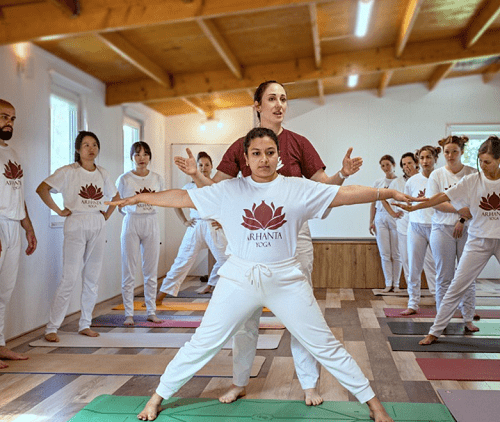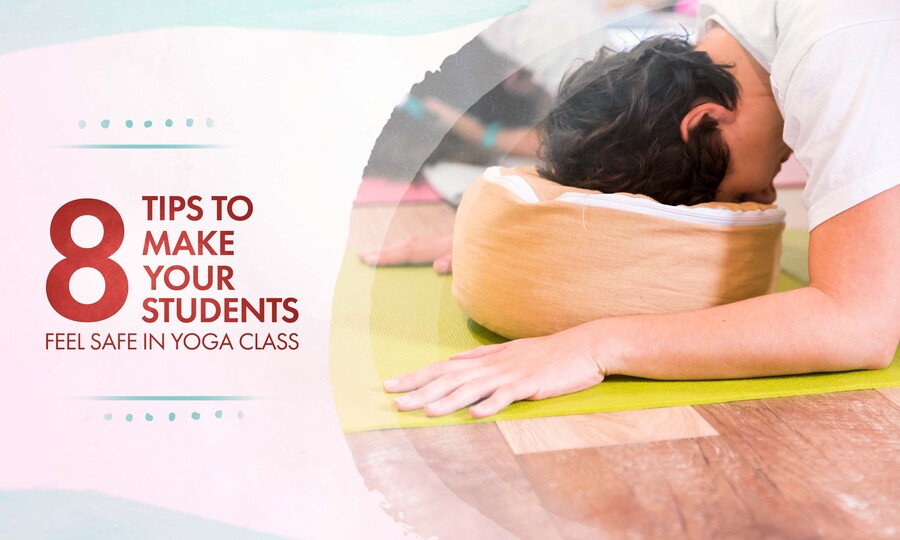The question of how to help make sure that your students feel safe in a yoga class setting is a hot and happening topic in the yoga scene. And. with good reason!
Firstly, because of a number of incidents of sexual abuse among yoga teachers reported in recent years.
Secondly, there is increasing awareness of the potential healing effects of yoga for trauma-related health issues. So, people coming to your class might be more trauma-sensitive than the general population.
And last but not least, there is a prevailing myth that yoga is free from the risk of injuries. This is simply not true. Yoga requires the body to move in ways it does not usually do. New students have to become more flexible and stronger step by step. It is therefore important to pay careful attention to the prevention of injuries when a student comes to your class for the first time.
As a yoga teacher, you should be aware of the effect the environment and your behavior might have on your students. How can you make new students feel safe in your yoga class setting? And how can you keep them safe? Here’s a list of do’s and don't s to create a physically and emotionally safe environment in your yoga classes.
4 Do's to Create a Safe Yoga Class Setting
1. Give an Informative Introduction
When a new student comes into your class, take a moment to introduce this new environment. You can show the student around. Show the student the studio, the changing room, and the toilet. Tell the student about your way of teaching, so she knows what to expect. It can also be helpful to name a few customs in a yoga class. For example, do you have any opening rituals such as chanting Om? Is there always time for tea or do you have another class directly after? In this way, you can give the student an idea of what is going to happen.
2. Create a Safe Yoga Class Setting by Asking about Injuries and Previous Experience
It helps to pay personal attention to the student. Is he familiar with yoga, or is it his first time? What expectations does the student have? Ask for injuries and tell the student how you normally deal with them - do you give adjustments, or do you recommend coming out of the pose in case of pain? Are students allowed to ask questions during the class? Does the student have any other questions before starting? In this way, you make the student feel welcome and safe in a yoga class setting.
3. Create a Neutral Environment
The environment of the studio is very important when it comes to safety. With trauma sensitivity in mind, it is best to stick with a neutral environment as a yoga class setting. All kinds of sensory triggers can cause anxiety, such as specific smells, sounds, or unexpected changes. If you use music, use gentle background music with very little (or no) vocals. And although the use of scents is quite common in a yoga class setting, it is not necessary. In order to create a safe yoga class setting, the lighting you use has an effect as well. Make sure the light is dim and comforting, instead of harsh or too dark. Overall, create a clear and neutral environment for a peaceful atmosphere.
4. Start Gently and Encourage a Mindfulness Practice
For new students, there is often a lot to learn. Instead of rushing into a sequence, slow down and invite the students to be mindful of their body, breath, and mind. This is beneficial not only for beginners but in general in a yoga class setting. It encourages self-awareness. Some gentle exercises to warm-up are also a good idea to prevent injuries. And including a resting pose, such as a child’s pose, at the beginning of your class is a good way to give the option of taking a rest whenever needed. If you are teaching an open class, you can talk to the new student before starting or name a few options while teaching.

Experience authentic Hatha Yoga
Get free access to exclusive guided lessons with master teacher Kalyani Hauswirth-Jain
4 Don'ts for Safety in a Yoga Class Setting
1. Don’t do Hands-on Adjustments without Asking for Permission (Instead, Use an Invitation to Say "No" in a Non-invasive Way)
Safety, especially in a trauma-sensitive approach, is largely about respecting personal boundaries and establishing trust. Therefore, asking permission before using touch is very important. This can be tricky, as saying "No" in public can be a challenge for some people, so simply asking at the beginning of class who is okay with it might not be enough.
A non-invasive way to ask for permission is to do this during opening meditation when most people have their eyes closed. You can invite your students to place one hand on their belly or shoulder if they do not want to be touched. Another option is to use cards that students can place next to their mat, depicting a ‘yes’ or ‘no’ for hands-on adjustments. This option even allows people to change their minds during class.
2. Don't Focus on Doing Everything Perfectly (Instead, be an Example of Self-compassion)
As a yoga teacher, you can use your role to show your students how to be compassionate. Allow yourself to make mistakes, to lose your balance now and then, and laugh about it. This takes off pressure on new students and people who tend toward perfectionism might learn to soften. Show your own human side and emphasize the beauty of practice instead of perfection. This helps add calm to a yoga class setting.
3. Don’t be Strict on Alignment Cues (Instead, use Invitational Language and Allow Students to Explore their Personal Experiences)
Safe practice in a yoga class setting includes the prevention of injuries. In some yoga poses, specific alignment cues might be helpful for one person, but harmful for another. As recognized more and more, each person is anatomically different. It’s important as a yoga teacher to acknowledge individual differences. So, try giving different options and use gentle, invitational language. In this way, you allow your students to explore their own bodies without judgment. You also significantly lower the risk of injuries.
Read an example of how to teach functional versus aesthetic alignment: How to Practice Pigeon Pose for All Levels of Mobility
4. Don’t Pretend you Know Everything (Instead, Refer your Students to a Specialist if you Don't have Expertise in the Medical Field)
In a yoga class setting and as a yoga teacher, you might get questions about a variety of health issues. If one of your students reports medical, physical, or mental conditions you don't know about in detail, refer the student to a specialist. Try not to make claims based on unfounded knowledge. Instead, acknowledge you cannot possibly know everything. If you do have qualifications in the medical field, of course, you can use your expertise to help your students in their practice. In this case, be aware though that teaching a yoga class is something different than offering therapy or medical consultation. Keep it simple and separate. This is the principle of being professional: Do what you are supposed to do to the best of your knowledge. No less, no more.
What to Consider in a Yoga Class Environment
1. How to create a Yoga Class Setting?
The first important aspect in creating a class atmosphere is the setting of your class. Where do you position yourself as a teacher and where do you place the mats of your students? Some yoga teachers feel uncomfortable in telling their students where they have to place their mats. As a consequence people place their yoga mat in an unorganized and chaotic manner. Create order in your class so that it is easier for the students to focus on being there in each moment.
2. Should I use Incense in a Yoga Class?
A common question when it comes to setting up a yoga class is whether to use incense or not. Maybe you have been to yoga classes where the room is small and the incense is burning throughout the practice. The room becomes smoky, the smell is too strong and after a while you just feel suffocated. Most probably this is not the atmosphere you are looking for. The use of incense can be very nice and relaxing. However if you decide to use incense it is advised to burn the incense at least 30 minutes before the starting of your class and make sure the smoke is gone before students enter the yoga room. A soft fragrance of incense can be very calming, but it is also important that the air is fresh and full of oxygen. During yoga practice you might also do some breathing exercises which definitely requires fresh air.
3. What Background Music Should I Use in a Yoga Class?
Using music in your yoga classes is not a must but it can be a helpful tool to guide people into a deeper relaxation. When you use music in your classes keep the volume to a minimum level. The choice of relaxing music is endless so surely you will find something that suits your needs. Keep in mind that soft instrumental music and nature sounds are very effective.
4. Can your Personal Outlook Influence a Yoga Class?
Creating a Safe Yoga Class Setting - Summing-it Up
In conclusion, making your students feel safe in yoga class includes different elements. Giving each student personal attention, acquainting new people with the environment, and asking about injuries can help you to establish trust and clarity. A calm and quiet environment creates safety in general. While teaching, focus on the prevention of injuries and respect boundaries in terms of touch. And finally, your own attitude as a teacher can be a tool to make students feel welcome and safe too. If you aren't a trained psychologist, I'd advise you from calling your classes trauma-sensitive yoga [1] classes. But even without it, the non-violence aspect is inherent in yogic philosophy and should be a given in any form of physical yoga practice too! Be compassionate and mindful, and don't forget to enjoy! This will make students not only feel safe in your class but confident as well.

Experience authentic Hatha Yoga
Get free access to exclusive guided lessons with master teacher Kalyani Hauswirth-Jain

